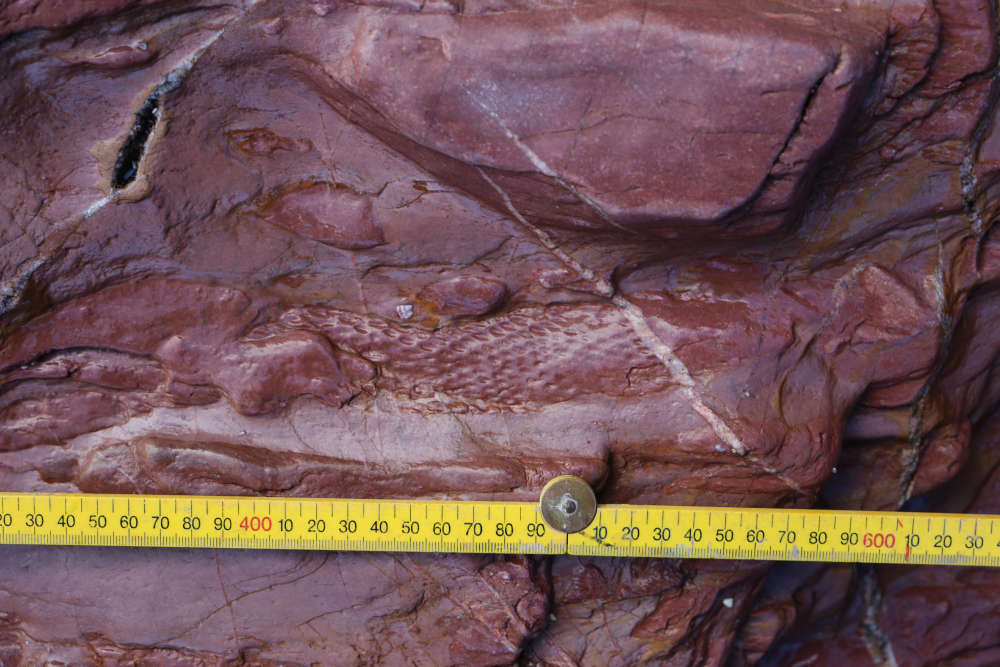
The English Riviera UNESCO Global Geopark is thrilled to announce a groundbreaking fossil discovery at Saltern Cove. This discovery will shed new light on our region's rich geological history.
The English Riviera UNESCO Global Geopark is thrilled to announce a groundbreaking fossil discovery at Saltern Cove. This discovery will shed new light on our region's rich geological history.
The fossils are of trees, and believed to be around 377 million years old, and were discovered by Dr Kevin Page during a condition survey of the Geopark’s Sites of Special Scientific Interest for Natural England. Dr Page is President of ProGEO and Honorary Senior Research Fellow at Camborne School of Mines, University of Exeter.
The fossils, identified as pieces of roots and bark belonging to primitive trees known as 'lycopsids', provide a unique glimpse into the ancient landscape of Torbay. Looking like our palm trees of today, these early, simple trees were the ancestors of giant trees that once contributed to coal formation. However, they are believed to have reached heights of just 4 meters.
This remarkable find is a testament to the unique and diverse landscape of the English Riviera UNESCO Global Geopark, which extends from Brixham to Maidencombe and encompasses the whole of Torbay and its marine territory. The discovery has sparked excitement among the scientific community. Dr Kevin Page said:
"These fossils are incredibly significant as they provide valuable insights into the prehistoric environment of Torbay, including the presence of volcanic islands with trees growing on them.”
“This could potentially be the first record of a Devonian desert island with trees, a truly remarkable find.”
Due to its significance, the discovery was kept under wraps for some time while the Geopark coordinated a working group. Experts from Universities of Exeter, Plymouth, Cardiff and Lille, along with Natural England came together to ensure the best and most appropriate outcomes for the find.
Following site visits and much discussion, it became clear that the fossils were at risk of erosion by the winter storms and the only option was to recover them. Being an area of international significance, the Geopark made sure all the required permissions were in place and expert care was taken to responsibly excavate and preserve the fossils for future generations. The recovery was conducted by expert geologists and safety measures including winching the fossils up a cliff were carried out by Hi Line and supervised by Health and Safety professionals.
The fossils are now safely housed at Torquay Museum before they undergo academic study and preparation. This research work allows the opportunity to learn more about the geological processes that shaped the English Riviera UNESCO Global Geopark. Ultimately, the fossils will return for display at Torquay Museum.
Melanie Border, Geopark Coordinator, said:
"We are incredibly excited about this fossil discovery at Saltern Cove,"
"To date our Devonian age rocks have only provided evidence of a marine environment but it’s very exciting to think we now have evidence of volcanic islands and trees too. It opens a new chapter of changing environments and conditions for us and highlights the importance of preserving and studying our natural heritage."
“The recovery has been a brilliant collaborative effort between the Universities, Natural England, Torbay Council, Torbay Coast and Countryside Trust, SWISCo, Hi-Line, and Waterside Holiday Park who allowed us to park and access the coast through their site.”
“I am extremely grateful for the help and support provided and would like to express a huge thank you to all involved.”
Saltern Cove is located along the South West Coast Path in Paignton. As part of the English Riviera UNESCO Global Geopark, it is designated as a Site of Special Scientific Interest (SSSI) and a Marine Local Nature Reserve. Access to Saltern Cove is currently closed due to storm damage. We will carry out repairs with the aim to reopen the Cove early next year.
For more information about the English Riviera UNESCO Global Geopark and to follow the story of the fossil going forward as it undergoes research, please visit www.englishrivierageopark.org.uk.

 Voting now open to celebrate Torbay and South Devon NHS Foundation Trust’s brilliant people
Voting now open to celebrate Torbay and South Devon NHS Foundation Trust’s brilliant people
 Find out about Fostering at one of Torbay’s events
Find out about Fostering at one of Torbay’s events
 Members of the public urged to help prevent drug overdoses
Members of the public urged to help prevent drug overdoses
 Community millions are ‘just sitting in the bank’
Community millions are ‘just sitting in the bank’











